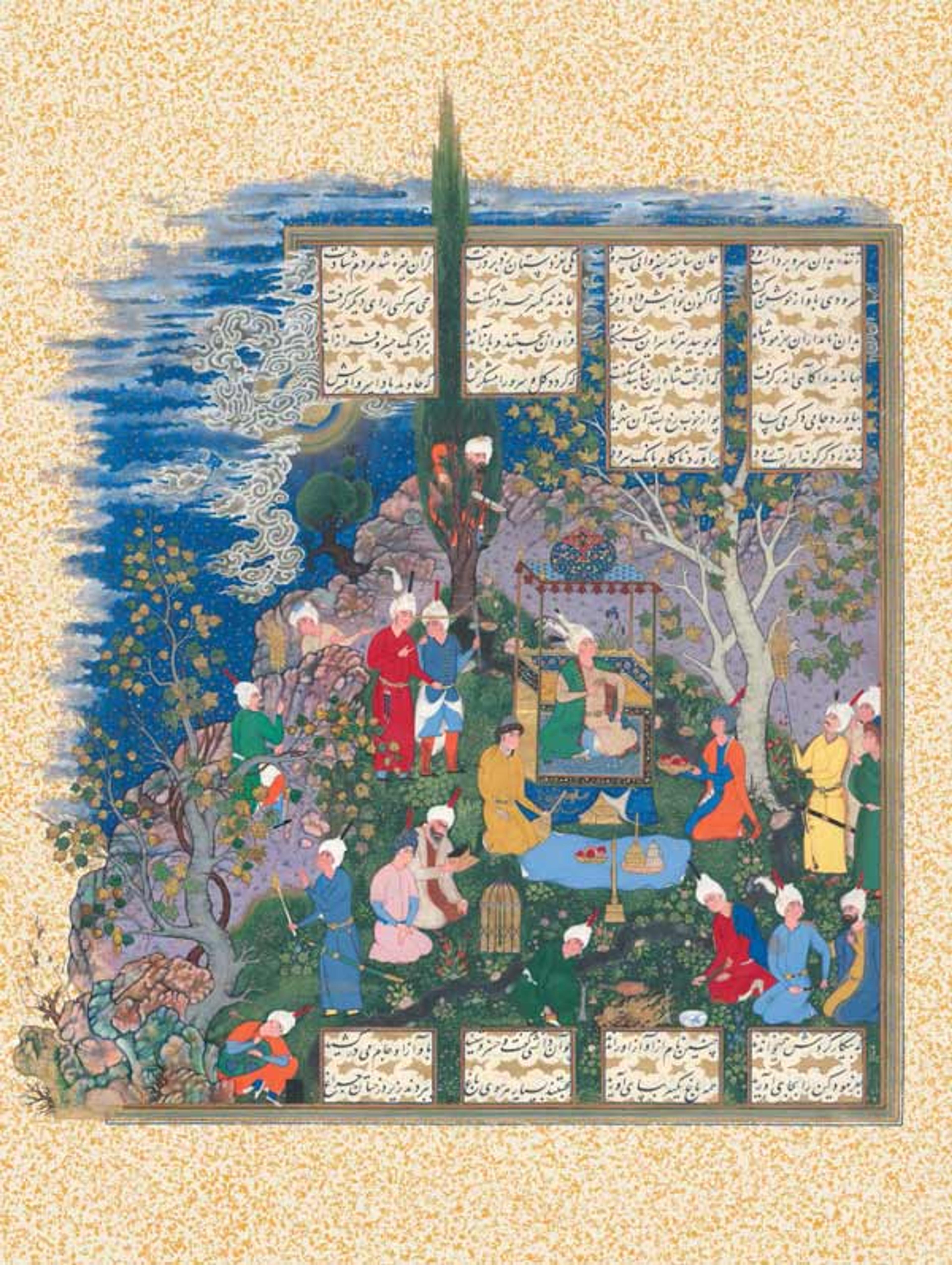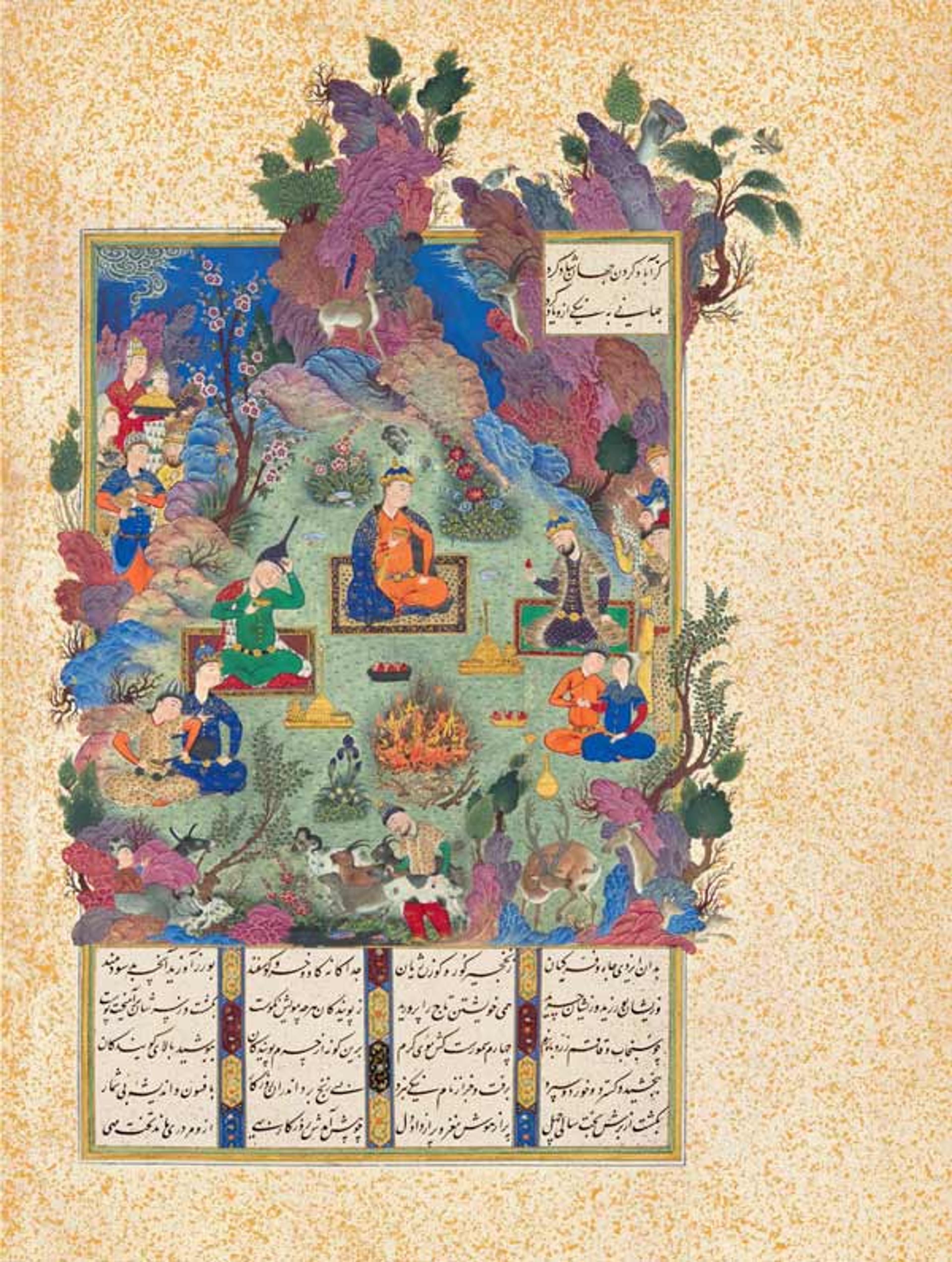Celebrating Nauruz with The Shahnama of Shah Tahmasp
The Shahnama of Shah Tahmasp, by Sheila Canby, features 530 full-color illustrations and is available at The Met Store and MetPublications
«The Shahnama of Shah Tahmasp is a tenth-century epic by the Persian poet Firdausi, chronicling Iran's mythical history before the founding of Islam. The Metropolitan Museum of Art's publication is a facsimile of the most lavishly illustrated version of the text, produced for the Safavid Shah Tahmasp, who ruled Iran from 1524 to 1576.»
Published in 2014, this more accessible version of the sold-out, prize-winning 2011 edition is more compact and includes an illustrated "who's who" that helps to identify the main characters in this masterpiece of manuscript illumination. This beautifully illustrated, historic manuscript makes an excellent gift, especially for Nauruz, the upcoming Persian New Year, on March 21.
In celebration of Nauruz, I spoke with Maryam Ekhtiar, curator in the Department of Islamic Art, about the holiday and The Shahnama of Shah Tahmasp.
Rachel High: Can you explain what Nauruz is for readers who don't know about the holiday?
Maryam Ekhtiar: Nauruz is the quintessential Persian holiday. It is observed in Iran, as well as in central Asia and some regions of the Caucasus. It is a festival that has been celebrated for over three thousand years and is rooted in Zoroastrian tradition. Nauruz is a celebration of the first day of spring, which coincides with the Vernal Equinox, so it falls at a different time each year. It is a time of renewal and cleansing after a long winter.
Families set a special table called the Haft Seen (seven seens or seven S's), which consists of various symbolic objects that represent rebirth and positive wishes for the new year. Seven of the items on the Haft Seen table start with the letter S. Every household sets its own Haft Seen, and family members gather around it when the year changes and exchange well-wishes. At Nauruz, people typically get together with their families, wear new clothes, visit their loved ones, and the older family members give the younger ones gifts. It is a really pleasant time of the year as the weather gets warmer and the flowers begin to bloom. It celebrates everything good about spring.
Left: The Shahnama of Shah Tahmasp makes a perfect Nauruz gift and a beautiful addition to the Haft Seen table, as demonstrated by this spread in the Museum's Editorial Department.

Did You Know?
Haft Seen means seven dishes. Each of these traditional dishes start with the letter S and are displayed on the Nauruz table. They include:
- sabza (wheat or lentil sprouts), representing rebirth
- samanu, a sweet pudding made of wheat sprouts, representing good food
- seeb (apples), representing health and beauty
- sinjid (dried lotus fruit), representing love
- seer (garlic), representing medicine
- sumaq (sumac berries), representing the color of sunrise; with the appearance of the sun, good conquers evil
- sirka (vinegar), representing age and patience
Additional good luck charms are also placed on the table. These may include:
- coins, representing prosperity and wealth
- a basket of painted eggs, representing fertility
- an orange floating in a bowl of water, representing the earth floating in space
- a goldfish in a bowl, representing life
- a flask of rose water, for its magical cleansing power
- a pot of flowering hyacinth or narcissus, representing the spring
- a mirror representing the images and reflections of Creation, which reaffirms the ancient Persian traditions and beliefs that the Creation took place on the first day of spring
- candles, representing enlightenment and happiness

This folio shows the preparations for the Nauruz feast. Barbad the Concealed Musician, Folio 731r. Attributed to Mirza 'Ali. The Nasser D. Khalili Collection of Islamic Art (MSS 1030)
Rachel High: The cover of the Met's publication depicts the detail of a painting showing preparations for the Nauruz feast, with the full image shown inside the book. Can you talk about this image, the book, and how it complements the holiday?
Maryam Ekhtiar: Nauruz is perhaps the most important Persian annual holiday. Historically, every annual holiday was marked by a royal feast, or a bazm. There are many depictions of feasting in The Shahnama of Shah Tahmasp, including the Feast of Sada, which celebrates the discovery of fire—fifty days before Nauruz. The preparation for the feast of Nauruz is depicted in the manuscript and shows the ruler enthroned, holding a shallow wine cup and a handkerchief—both emblems of royalty. He is surrounded by attendants and cooks who offer him wine and fruits and roast a lamb over a fire.
The bazm is usually accompanied by music and poetry, represented here by Barbad, who plays a string instrument called a barbat in a tree. Fire has important symbolic associations in Persian celebrations. In addition to the Feast of Sada, Fire Wednesday (Chahar-shanba Suri), which occurs on the Wednesday before Nauruz, uses fire to usher in the new year. The ritual dates back centuries and involves lighting bunches of kindling in a row and jumping over the flames, an action thought to rid the jumper of the bad and bring in the good.

Folio showing the celebration of the Feast of Sada. "The Feast of Sada," Folio 22v from the Shahnama (Book of Kings) of Shah Tahmasp, ca 1525. Author: Abu'l Qasim Firdausi (935–1020); painting attributed to Sultan Muhammad (active first half 16th century). Iran. Tabriz. Opaque watercolor, ink, silver, and gold on paper; Painting: H. 9 1/2 in. (24.1 cm) W. 9 1/16 in. (23 cm); Page: H. 18 1/2 in. (47 cm) W.12 1/2 in. (31.8 cm); Mat: H. 22 in. (55.9 cm) W. 16 in. (40.6 cm). The Metropolitan Museum of Art, New York, Gift of Arthur A. Houghton Jr., 1970 (1970.301.2)


Left: Details from Barbad the Concealed Musician, showing a candle and cooking flame, and a lighted torch. Barbad the Concealed Musician, Folio 731r (detail). Attributed to Mirza 'Ali. The Nasser D. Khalili Collection of Islamic Art (MSS 1030)
The Shahnama celebrates the tradition of Persian kingship from legendary times to before the Arab invasions in the seventh century. After the Arab invasions, Arabic infiltrated the Persian language, and one of the aims of the Shahnama was to rejuvenate the Persian language and to restore it to its past glory. So, the Shahnama exemplified what it meant to be Persian and to be a successful king in every sense of the word. Of course, this included participating in the ritual of feasting (bazm) during annual holidays.
Rachel High: What are some of your favorite Nauruz traditions?
Maryam Ekhtiar: The setting of the Haft Seen table is a beautiful tradition—I like its symbolic associations and the fact that it brings family members together. Also, there is a ritual tune that is played when the new year arrives that I always enjoyed as a child growing up in Iran. It is a happy time, people call each other and exchange gifts.
Celebrating Nauruz is part of being an Iranian, taking pride in your heritage, and connecting with your history and your community. At the Met there's an annual dinner where members of the Iranian community come together to celebrate Nauruz. Iranians make great efforts to keep this tradition alive!
Related Links
The Met Store:The Shahnama of Shah Tahmasp
Heilbrunn Timeline of Art History:"The Shahnama of Shah Tahmasp"
Bazm and Razm: Feast and Fight in Persian Art, on view February 17–May 31, 2015
FarsiNet
Rachel High
Rachel joined the Publications and Editorial Department in 2014 where she has previously held the roles of Publishing and Marketing Assistant and Assistant for Administration. She manages the MetPublications website, the Museum's text licensing program in all languages, and the @MetPubs Instagram account. In addition to her work marketing The Met's titles, Rachel also consults on Museum co-publications and the Costume Institute catalogues. She has been a speaker at the National Museum Publishing Seminar and is an organizing member of the International Association of Museum Publishers. She holds a B.A. in Art History from New York University and an M.A. in Art History from Hunter College. Her own research centers on the intersections of art and publishing.
Selected publications
“Something Else Press as Publisher.” Master’s thesis, Hunter College, City University of New York, 2020. CUNY Academic Works.